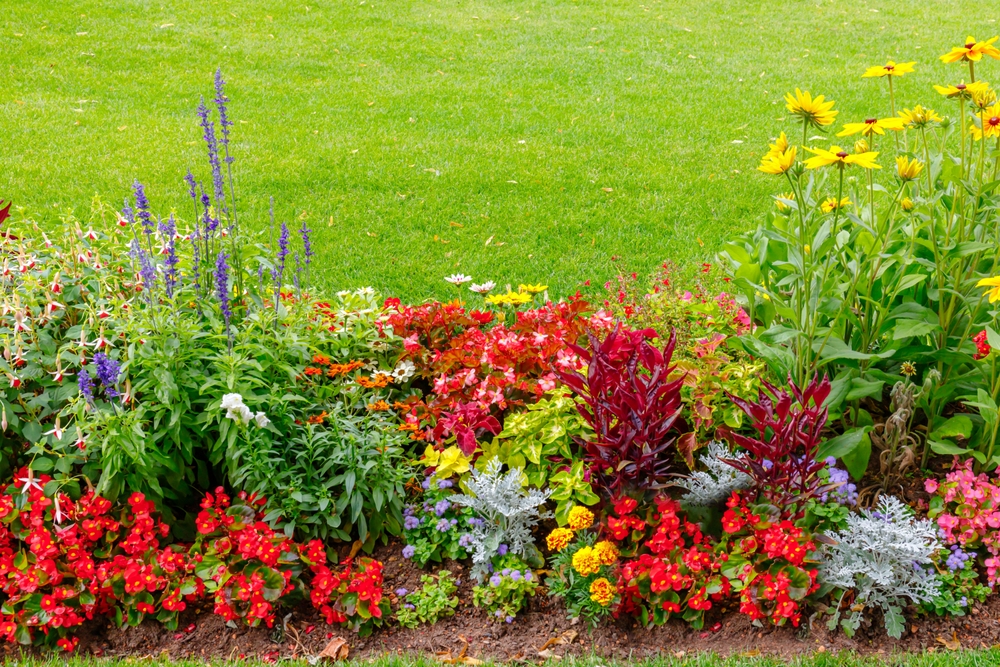
Image Source: Shutterstock.com
Fall isn’t just for pumpkin spice, cozy sweaters, and leaf piles—it’s also one of the most underrated times to give your garden some serious love. When most people are packing up their tools and saying goodbye to summer blooms, smart gardeners are out there redefining their flower beds—literally. Re-edging in the fall does more than just clean up the look of your landscape; it prepares your garden for spring glory.
The crisp air, softened soil, and fading foliage make it the perfect moment to sharpen those borders and breathe new life into your flower beds. If you’ve been eyeing those uneven edges all season long, now’s your chance to make them picture-perfect before the frost sets in.
1. The Perennial Power Bed
Perennial flower beds are the heart of many home gardens, and fall is the ideal time to give them a crisp refresh. By this point in the year, perennials have likely grown a bit wild—spilling over their borders like an overenthusiastic party guest. Re-edging helps you restore clean lines, making the bed look tidy while giving roots more space to breathe before their winter nap. A defined border also prevents grass from creeping in and stealing nutrients. The best part? When spring returns, those revived perennials will look like they’ve had a professional makeover while you were busy sipping hot cocoa all winter.
2. The Bulb-Friendly Bed
If you’re planning to plant bulbs for next spring’s tulips, daffodils, or hyacinths, re-edging before you dig is a game-changer. Freshly cut edges help you visualize the space, ensuring that your bulb placement looks intentional instead of random. Plus, it helps keep mulch neatly in place, protecting your bulbs from frost heave and hungry critters. A well-edged bulb bed also prevents water from pooling in awkward spots, which can cause rot. Think of it as setting the stage for a stunning spring performance—the cleaner your borders, the better your blooms will shine when the curtain rises.
3. The Rose Retreat
Roses are the divas of the garden—beautiful, high-maintenance, and worth every bit of effort. As fall arrives and rose bushes start to slow their bloom, it’s the perfect time to redefine their territory. Re-edging a rose bed helps you control surrounding weeds and ensures mulch stays right where it belongs, locking in warmth for the roots during chilly nights. It also improves drainage, which roses adore. By creating a smooth, structured border, you not only make your rose garden look magazine-worthy but also set it up for healthier growth come springtime.
4. The Shade Garden Sanctuary
Shady spots often get overlooked when it comes to maintenance, but their borders can quickly blur as groundcovers like hostas and ferns spread out. Fall re-edging gives these cool, quiet spaces a refreshing sense of order without disturbing their tranquil vibe. Cutting back the edge helps manage root spread and keeps the shaded area distinct from the rest of your yard. It also creates better definition between mulch and grass, which instantly boosts your curb appeal even when most plants are fading. There’s something incredibly satisfying about seeing a neat, crisp line around your shade garden—it’s like your landscape just exhaled in relief.
5. The Mixed Border Marvel
Mixed beds—those lush, colorful blends of annuals, perennials, and shrubs—tend to become wild jungles by late summer. Re-edging them in the fall brings back a sense of balance and control. With cooler temperatures, it’s easier to work the soil, and trimming the edges lets you spot areas that might need replanting or thinning before winter sets in. A defined edge also helps separate mulch and soil from your lawn, keeping things cleaner through the stormy months. When the first snow dusts your yard, those tidy borders will still look intentional and beautiful, a reminder of your end-of-season effort.

Image Source: Shutterstock.com
6. The Curbside Showstopper
Your front-yard flower beds are the first thing people see—and by fall, they’ve probably lost some of their early-season sparkle. Re-edging them now gives your curb appeal a major boost just in time for the holidays. Clean lines make even dormant or fading plants look polished and cared for. It also gives you a perfect opportunity to add fresh mulch or winter-friendly accents like ornamental grasses and evergreen shrubs. A sharp, well-defined edge around your curbside bed turns heads and tells the neighborhood, “Yes, my garden looks good year-round—thank you very much.”
Don’t Let Fall Fade Without a Fresh Edge
While most people think of gardening as a spring affair, fall is the secret weapon of savvy landscapers. Re-edging your flower beds now not only tidies up your yard but also sets the stage for a smoother, healthier growing season ahead. It’s a small job with big rewards—clean lines, better drainage, happier roots, and a landscape that looks stunning even as the leaves fall. So grab your edging tool, throw on your favorite flannel, and give your garden that sharp new outline it deserves.
Have you tried re-edging your beds in the fall? Share your tips, stories, or favorite before-and-after moments in the comments section.
You May Also Like…
Why Bees Seek Late-Blooming Flowers in Autumn
6 Wildflowers to Scatter Before the Snow Comes
Why Compost Layers Matter More in Fall
Why Moisture Levels Matter More in Autumn
How to Prep Raised Beds for Snowfall
Leave a Reply